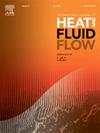Viscosity-driven clustering of heated polydispersed particles in subsonic jet flows
IF 2.6
3区 工程技术
Q2 ENGINEERING, MECHANICAL
International Journal of Heat and Fluid Flow
Pub Date : 2025-02-11
DOI:10.1016/j.ijheatfluidflow.2025.109754
引用次数: 0
Abstract
The clustering of heated particles is known to increase with the rise in local gas viscosity, even at particle Stokes number . Despite being a dominant effect that holds in two-way coupling (TWC), this rise in clustering has been only probed in a triply periodic box via direct numerical simulations (DNS), in which the flow evolves temporally and the total volume (and mean fluid density) is fixed. We conduct DNS to study the dispersion of heated polydispersed particles in a spatially developing subsonic confined jet flow, where energy and momentum are modeled with TWC. Although there is only a increase in gas viscosity in the heated particle-laden simulation, it is sufficient to limit the particles within the central hot region of the jet. The particles traveling laterally start clustering at a thermal front created at the outer periphery of the jet. Thus, their lateral dispersion is also limited. Despite starting with the same values as their unheated counterparts, the heated particles yield more concentrated clusters within the jet as the number of heated particles declines sharply in the lateral direction. This is a compounding effect, where the presence of particles within the jet can produce more significant thermal changes inside the jet, which can further restrict the lateral movement of the particles. Experiencing identical eddies inside the jet causes particles of all sizes in the heating case to cluster at similar locations in the domain. These findings can considerably aid applications such as targeted drug delivery and cold spray coating techniques.
亚音速射流中加热多分散颗粒的粘度驱动聚类
已知加热颗粒的聚集随着局部气体粘度的增加而增加,即使在颗粒斯托克斯数St<;1时也是如此。尽管在双向耦合(TWC)中起主导作用,但聚类的增加仅通过直接数值模拟(DNS)在三周期盒中进行了探测,其中流动是暂时演变的,总体积(和平均流体密度)是固定的。我们使用DNS来研究加热的多分散粒子在空间发展的亚音速受限射流中的分散,其中能量和动量用TWC建模。虽然在加热颗粒加载模拟中,气体粘度只增加了16%,但这足以将颗粒限制在射流的中心热区内。横向移动的粒子开始聚集在射流外围形成的热锋处。因此,它们的横向分散也是有限的。尽管初始St值与未加热颗粒相同,但随着加热颗粒数量在横向上急剧下降,加热颗粒在射流内产生更集中的团簇。这是一种复合效应,射流中颗粒的存在会在射流内部产生更显著的热变化,从而进一步限制颗粒的横向运动。在射流内部经历相同的涡流会导致加热情况下各种大小的颗粒聚集在区域的相似位置。这些发现可以极大地帮助应用,如靶向药物输送和冷喷涂涂层技术。
本文章由计算机程序翻译,如有差异,请以英文原文为准。
求助全文
约1分钟内获得全文
求助全文
来源期刊

International Journal of Heat and Fluid Flow
工程技术-工程:机械
CiteScore
5.00
自引率
7.70%
发文量
131
审稿时长
33 days
期刊介绍:
The International Journal of Heat and Fluid Flow welcomes high-quality original contributions on experimental, computational, and physical aspects of convective heat transfer and fluid dynamics relevant to engineering or the environment, including multiphase and microscale flows.
Papers reporting the application of these disciplines to design and development, with emphasis on new technological fields, are also welcomed. Some of these new fields include microscale electronic and mechanical systems; medical and biological systems; and thermal and flow control in both the internal and external environment.
 求助内容:
求助内容: 应助结果提醒方式:
应助结果提醒方式:


